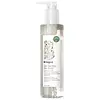What's inside
What's inside
 Key Ingredients
Key Ingredients

 Benefits
Benefits

 Concerns
Concerns

 Ingredients Side-by-side
Ingredients Side-by-side

Water
Skin ConditioningSodium Lauroyl Methyl Isethionate
CleansingCocamidopropyl Betaine
CleansingGlycerin
HumectantAloe Barbadensis Leaf Juice
Skin ConditioningAvena Sativa Bran Extract
AbrasiveCamellia Sinensis Leaf Extract
AntimicrobialLimnanthes Alba Seed Oil
Skin ConditioningPanthenol
Skin ConditioningSodium Gluconate
Skin ConditioningCitric Acid
BufferingLeuconostoc/Radish Root Ferment Filtrate
AntimicrobialPanthenyl Hydroxypropyl Steardimonium Chloride
Tocopheryl Acetate
AntioxidantPotassium Sorbate
PreservativeSodium Benzoate
MaskingCaprylhydroxamic Acid
Benzyl Alcohol
PerfumingWater, Sodium Lauroyl Methyl Isethionate, Cocamidopropyl Betaine, Glycerin, Aloe Barbadensis Leaf Juice, Avena Sativa Bran Extract, Camellia Sinensis Leaf Extract, Limnanthes Alba Seed Oil, Panthenol, Sodium Gluconate, Citric Acid, Leuconostoc/Radish Root Ferment Filtrate, Panthenyl Hydroxypropyl Steardimonium Chloride, Tocopheryl Acetate, Potassium Sorbate, Sodium Benzoate, Caprylhydroxamic Acid, Benzyl Alcohol
Water
Skin ConditioningSodium C14-16 Olefin Sulfonate
CleansingCocamidopropyl Betaine
CleansingSodium Methyl Cocoyl Taurate
CleansingSodium Lauroamphoacetate
CleansingLauryl Glucoside
CleansingDisodium Laureth Sulfosuccinate
CleansingBetaine
HumectantPhenoxyethanol
PreservativeSodium Lauryl Sulfoacetate
CleansingDimethicone Propyl Pg-Betaine
CleansingArginine
MaskingAvena Sativa Peptide
Skin ConditioningPhosphatidylcholine
EmulsifyingMoringa Oleifera Seed Oil
EmollientLaurdimonium Hydroxypropyl Hydrolyzed Keratin
Skin ConditioningArginine Hcl
Skin ConditioningGlycol Distearate
EmollientGuar Hydroxypropyltrimonium Chloride
Skin ConditioningIsostearamide Mipa
Polyquaternium-47
Skin ConditioningCitric Acid
BufferingPolyquaternium-7
Laureth-4
EmulsifyingPEG-120 Methyl Glucose Dioleate
EmulsifyingDimethicone PEG-8 Meadowfoamate
EmollientPEG-4 Laurate
EmulsifyingQuaternium-80
Methyl Gluceth-10
EmulsifyingMethoxy PEG/PPG-7/3 Aminopropyl Dimethicone
Tetrasodium EDTA
Glyceryl Laurate
EmollientTocopherol
AntioxidantRosa Canina Fruit Oil
EmollientDipropylene Glycol
HumectantC10-40 Isoalkylamidopropylethyldimonium Ethosulfate
Sodium Hydroxide
BufferingIodopropynyl Butylcarbamate
PreservativeCitronellol
PerfumingParfum
MaskingWater, Sodium C14-16 Olefin Sulfonate, Cocamidopropyl Betaine, Sodium Methyl Cocoyl Taurate, Sodium Lauroamphoacetate, Lauryl Glucoside, Disodium Laureth Sulfosuccinate, Betaine, Phenoxyethanol, Sodium Lauryl Sulfoacetate, Dimethicone Propyl Pg-Betaine, Arginine, Avena Sativa Peptide, Phosphatidylcholine, Moringa Oleifera Seed Oil, Laurdimonium Hydroxypropyl Hydrolyzed Keratin, Arginine Hcl, Glycol Distearate, Guar Hydroxypropyltrimonium Chloride, Isostearamide Mipa, Polyquaternium-47, Citric Acid, Polyquaternium-7, Laureth-4, PEG-120 Methyl Glucose Dioleate, Dimethicone PEG-8 Meadowfoamate, PEG-4 Laurate, Quaternium-80, Methyl Gluceth-10, Methoxy PEG/PPG-7/3 Aminopropyl Dimethicone, Tetrasodium EDTA, Glyceryl Laurate, Tocopherol, Rosa Canina Fruit Oil, Dipropylene Glycol, C10-40 Isoalkylamidopropylethyldimonium Ethosulfate, Sodium Hydroxide, Iodopropynyl Butylcarbamate, Citronellol, Parfum
Ingredients Explained
These ingredients are found in both products.
Ingredients higher up in an ingredient list are typically present in a larger amount.
Citric Acid is an alpha hydroxy acid (AHA) naturally found in citrus fruits like oranges, lemons, and limes.
Like other AHAs, citric acid can exfoliate skin by breaking down the bonds that hold dead skin cells together. This helps reveal smoother and brighter skin underneath.
However, this exfoliating effect only happens at high concentrations (20%) which can be hard to find in cosmetic products.
Due to this, citric acid is usually included in small amounts as a pH adjuster. This helps keep products slightly more acidic and compatible with skin's natural pH.
In skincare formulas, citric acid can:
While it can provide some skin benefits, research shows lactic acid and glycolic acid are generally more effective and less irritating exfoliants.
Most citric acid used in skincare today is made by fermenting sugars (usually from molasses). This synthetic version is identical to the natural citrus form but easier to stabilize and use in formulations.
Read more about some other popular AHA's here:
Learn more about Citric AcidCocamidopropyl Betaine is a fatty acid created by mixing similar compounds in coconut oil and dimethylaminopropylamine, a compound with two amino groups.
This ingredient is a surfactant and cleanser. It helps gather the dirt, pollutants, and other impurities in your skin to be washed away. It also helps thicken a product and make the texture more creamy.
Being created from coconut oil means Cocamidopropyl Betaine is hydrating for the skin.
While Cocamidopropyl Betaine was believed to be an allergen, a study from 2012 disproved this. It found two compounds in unpure Cocamidopropyl Betaine to be the irritants: aminoamide and 3-dimethylaminopropylamine. High-grade and pure Cocamidopropyl Betaine did not induce allergic reactions during this study.
Learn more about Cocamidopropyl BetaineWater. It's the most common cosmetic ingredient of all. You'll usually see it at the top of ingredient lists, meaning that it makes up the largest part of the product.
So why is it so popular? Water most often acts as a solvent - this means that it helps dissolve other ingredients into the formulation.
You'll also recognize water as that liquid we all need to stay alive. If you see this, drink a glass of water. Stay hydrated!
Learn more about Water